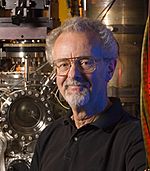Ward Plummer facts for kids
Quick facts for kids
E. Ward Plummer
|
|
|---|---|
 |
|
| Born | October 30, 1940 |
| Died | July 23, 2020 (aged 79) Baton Rouge, Louisiana, US
|
| Nationality | American |
| Alma mater | Lewis & Clark College (B.A.) Cornell University (Ph.D.) |
| Known for | Photoemission |
| Awards | Wayne B. Nottingham Prize, Davisson-Germer Prize in Atomic or Surface Physics, Medard W. Welch Award |
| Scientific career | |
| Fields | Surface physics |
| Institutions | University of Pennsylvania Louisiana State University University of Tennessee |
| Thesis | Binding of the 5d-transition elements on single crystal tungsten surfaces. (1968) |
| Doctoral advisor | Thor Rhodin |
Earl Ward Plummer (born October 30, 1940 – died July 23, 2020) was a brilliant American physicist. He was famous for his work on how the surfaces of metals behave. This area of study is called surface physics. Dr. Plummer taught physics at two big universities: Louisiana State University and the University of Pennsylvania.
Contents
About Ward Plummer's Life
Ward Plummer started his journey in science by earning a Bachelor of Arts degree from Lewis & Clark College in 1962. He then went on to get his Ph.D. in physics from Cornell University in 1967. While at Cornell, he worked with Professor Thor Rhodin. His Ph.D. research focused on how atoms stick to the surfaces of metals. He used a special tool called a Field ion microscope for this work.
Early Research at NIST
After finishing his Ph.D., Dr. Plummer joined the National Bureau of Standards in 1967. Today, this place is known as the National Institute of Standards and Technology (NIST). He worked there as a scientist until 1973. During this time, he studied how electrons behave when they leave metal surfaces. This is related to something called the photoelectric effect.
One of his most important papers was published in 1969. It was about "Resonance Tunneling of Field-Emitted Electrons Through Adsorbates on Metal Surfaces." This paper was so important that NIST chose it as one of their top 100 articles of the 20th century. In this research, Dr. Plummer and his team were the first to see the energy levels of single atoms on a metal surface. This was a big step forward in understanding materials at a tiny scale.
Working at Universities
In 1973, Dr. Plummer became a professor in the Physics Department at the University of Pennsylvania. Here, his research focused on how light and electrons interact with surfaces. He studied things like angle-resolved photoemission, which helps scientists understand the electronic structure of materials. He also looked at how surfaces respond to light in unusual ways.
Later, in 1993, Dr. Plummer moved to a new role. He worked jointly at The University of Tennessee, Knoxville, and Oak Ridge National Laboratory. His research changed to studying how materials change at an atomic level. He was especially interested in transition-metal oxides. For this work, he often used a very powerful microscope called a Scanning tunneling microscope. This microscope can see individual atoms on a surface.
Helping Young Scientists
Dr. Plummer was a very productive scientist, writing over 400 scientific papers. He was even listed among the 1,000 most cited physicists. But what he was most proud of was helping young scientists. He guided 40 graduate students through their Ph.D. studies. He also hosted about 25 postdoctoral fellows. He helped many young researchers start their own successful careers in science. Dr. Plummer passed away in Baton Rouge on July 23, 2020.
Awards and Honors
Dr. Ward Plummer received many important awards for his scientific work:
- 1968 Wayne B. Nottingham Prize
- 1983 Davisson-Germer Prize in Atomic or Surface Physics from the American Physical Society. He won this for his new ways of using electron spectroscopy.
- 1986 Guggenheim Fellowship
- 2001 Medard W. Welch Award by the American Vacuum Society. This award recognized him for creating new tools and using them to discover new ideas in surface physics. It also honored him for mentoring young scientists.
- 2006 - Elected to the National Academy of Sciences. This is a very high honor for scientists in the United States.
- 2014 - Elected to the American Academy of Arts and Sciences.
- 2017 - International Science and Technology Cooperation Award of the People's Republic of China.
- 2017 - LSU Boyd Professor. This is the highest academic rank at Louisiana State University.

